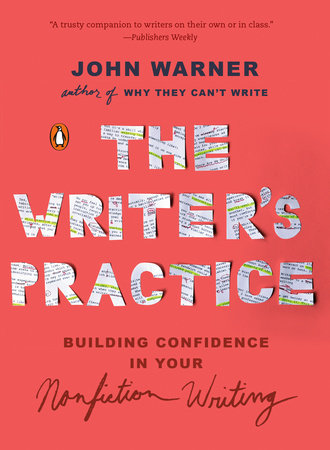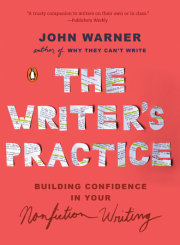Before We Begin . . . Do me a favor and write down how to make a peanut-butter-and- jelly sandwich. You can even write it right in the book if you want. It’s a good thing to write in books, and I’ve asked the publisher to leave some room.
WRITING EXPERIENCES
In this book, rather than “assignments” or “essays,” I want us to consider what we’re doing in terms of “experiences.” While you’ve likely done lots of writing, for our purposes, you’ve just completed your first writing “experience.” How did you do?
Take a moment to visualize what would happen if someone who is unfamiliar with making a peanut-butter-and-jelly sandwich could successfully make an acceptable sandwich with your instruc- tions.
What would they do? What’s missing?
For example, is there a line like “Take the peanut butter and spread it on one side of the bread”?
Picture someone following this instruction literally.
It does not tell this person how much peanut butter to spread or what to spread it with. A true literalist would actually be rubbing the closed peanut butter jar against a piece of bread.
Mmm . . . delicious.
Maybe this seems picky or ridiculous, but imagine leaving out key instructions for something not as mundane as making a peanut-butter-and-jelly sandwich.
Take a couple of minutes to see all the mistakes you might cause if someone followed your instructions to the letter.
LEARNING FROM EXPERIENCES
Do not feel bad if you now recognize your instructions as subpar. I set you up for failure. Over the years, I have asked hundreds, maybe thousands, of people, ranging from students to tenured
professors to published writers, to prepare instructions for making a peanut-butter-and-jelly sandwich, and almost invariably they make very similar mistakes.
They make mistakes because I purposefully neglected to mention an audience in the instructions, and by not doing this I have induced them to be careless and inconsiderate of the audience’s needs. This is forgivable since they didn’t know the audience existed.
Most people, when asked to do this, write a vague description of themselves making a sandwich. In their minds, they picture the steps as
they see them, rather than through the eyes of an inexperienced sandwich maker.
Now that you are aware of an audience, you would likely change your directions in significant ways.
Being “audience aware” while working is one of the most important skills writers develop. Over time, it becomes second nature to ask yourself if the choices you’re making are good ones.
You are already a more experienced writer with an improved appreciation for the role of the audience in writing, and we’ve just barely started.
Before we move on to more experiences, I want to answer some questions you might be having.
QUESTIONS ABOUT THIS BOOK
WHO IS IT FOR?
This book is for anyone who wants to improve their writing, which is everyone because everyone is a writer.
Think about it. You write all the time. You text, you e-mail, you interact on social media, you make lists, and you write for school or work or both. On any given day, you write thousands of words. Writing is communication. If you’re trying to convey a specific message to a specific audience to fulfill a specific purpose, you’re
writing
HOW DOES IT WORK?
We get better at writing the same way we get better at anything else: by doing it. This book is designed for doing things that allow you to practice the “writer’s practice.”
Yes, you are going to practice your practice: the attitudes, skills, habits of mind, and knowledge that writers engage with when they are writing. Ultimately, the goal is to think and act as a writer whenever you are confronted with a writing task.
You will practice your practice by engaging with different experiences, after which you will reflect on the experience to better understand what you’ve learned and can apply the next time you are confronted with a writing-related problem.
The experience of writing instructions for a peanut-butter-and- jelly sandwich has likely already allowed you to reflect on how important it is to consider your audience before you start writing. Now that we know that considering the audience is a key to effective communication, we will do it from this moment forward.
Writing is a skill, but it’s a skill that can appear to disappear when we move from a familiar writing task to an unfamiliar writing task. Reflection is a way to transfer what we know about writing in one arena to a new arena by understanding the similarities and identifying the differences and adjusting accordingly.
It’s like an athlete looking at game tape or a musician reviewing a performance. We’re asking: What happened? What did I learn? What will I do differently the next time?
Eventually enough experience accrues and you have a battle-tested process for tackling any writing task, no matter how unfamiliar.
WHAT DO I NEED?
There are no prerequisites for having these experiences, and there is no one so experienced that they can’t benefit from them. In fact, once I started thinking about writing as a series of experiences, I became a much better writer. When I need to write something unfamiliar, I now try to break it down as a writing experience. Once you’ve had enough experiences, you too will be able to take an unfamiliar writing task and break it down into its component parts.
You’ll want to keep track of your writing experiences one way or another, but you should use the writing tools with which you’re most comfortable. I’m a word-processing software person myself, but if you’re a chisel and stone tablet type, all blessings to you.
In addition to the experiences themselves, I’ve included chapters designed to allow for deeper, big-picture reflection about what you’re learning.
WILL THIS WORK IN A CLASS?
The experiences are designed to be adaptable to a class context. An instructor can add elements such as grading criteria, deadlines, word counts, specific readings, peer response, or anything else necessary to fit the structures and rhythms of school. Almost all of these experiences were born in the college classrooms in which I’ve worked for twenty years.
In the appendix, I’ve included possible assignment sequences that may be useful in planning a contained, semester-long course. It’s important to remember that these are designed to be “experiences,” and the meaning is in the doing. This leaves room for any necessary alterations to meet specific curricular needs or demands.
WHAT IF I’M WORKING ALONE?
Care has been taken to make all experiences self-contained and doable on your own. Because we always write for audiences, at times you will be asked to find someone to test your writing’s effectiveness on, but following the process will provide you with enough information and context to complete the experience and, in turn, increase your knowledge of and confidence in your own writing.
HOW DO I START?
You’ve already started. Now that you’ve started, you should try as many experiences as you like. Some can take as little as a few minutes, while others may stretch over days or weeks. Many of these experiences can be repeated over and over, and you will continue to learn new things each time.
Just like a musician, you may choose to “play” the same piece over and over, and find you become more deeply familiar with a particular writing experience each time around. The learning is always in the doing.
WHERE ARE WE GOING?
I have been writing seriously for more than twenty-five years and teaching for twenty. I am certain that everyone can learn to write, but to achieve this the writer must be in charge of their own learning.
This book is here to give shape to your practice, and encourage you to work purposefully toward increased proficiency.
While you will quite quickly amass experience, it’s important to recognize that there is no terminal expertise in writing. You will get a little better every time you do it, but you will never reach a finish line after which you will cease to improve.
This is one of the best things about writing with purpose and writing through different experiences.
May as well keep going by next figuring out who you are as a writer.
Copyright © 2019 by John Warner. All rights reserved. No part of this excerpt may be reproduced or reprinted without permission in writing from the publisher.




